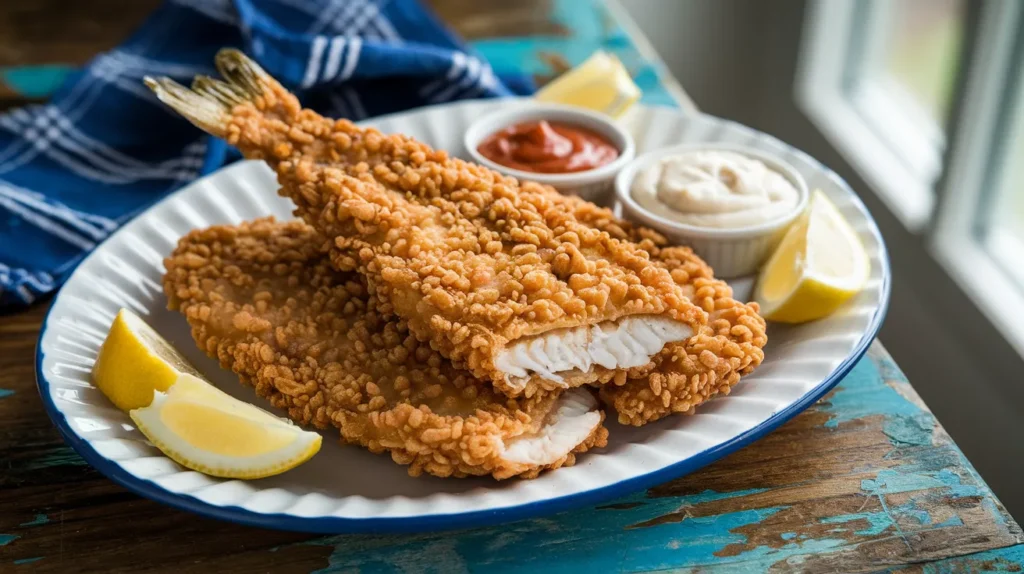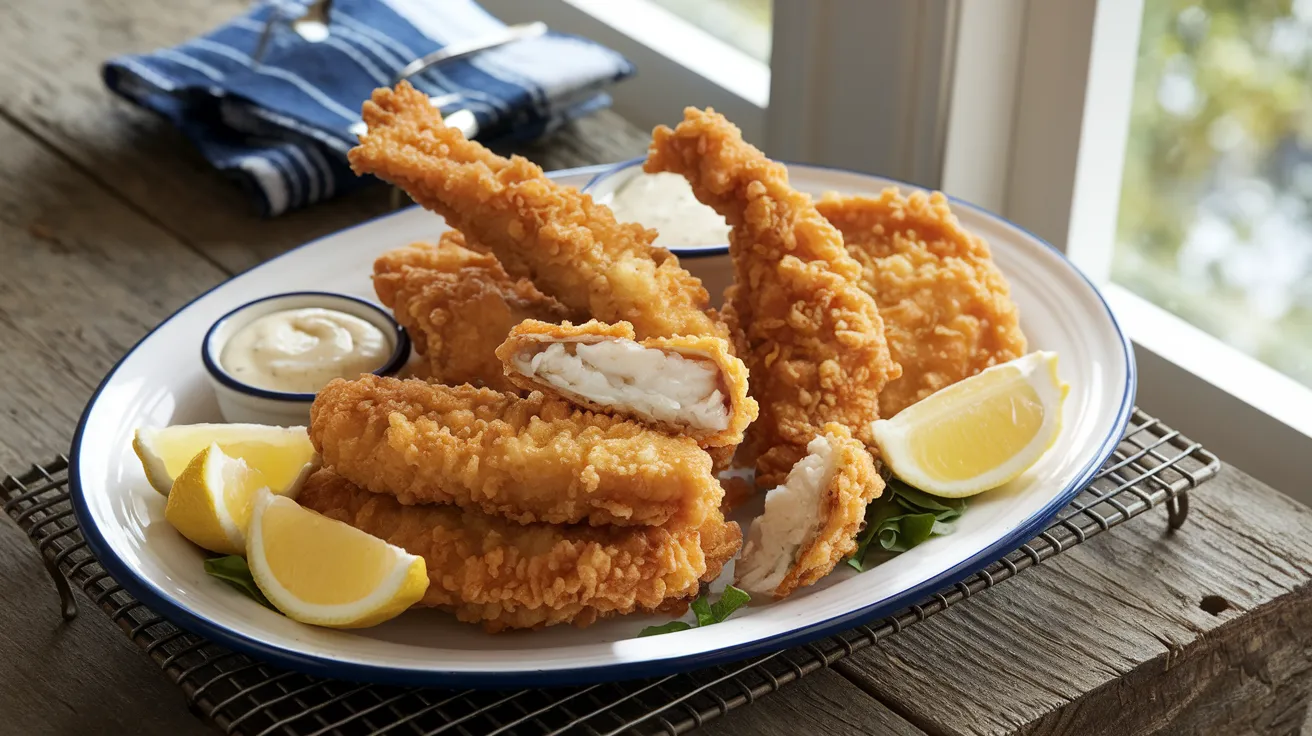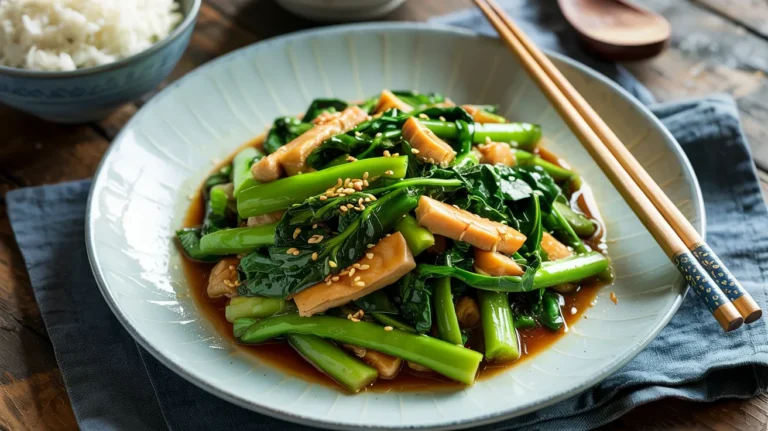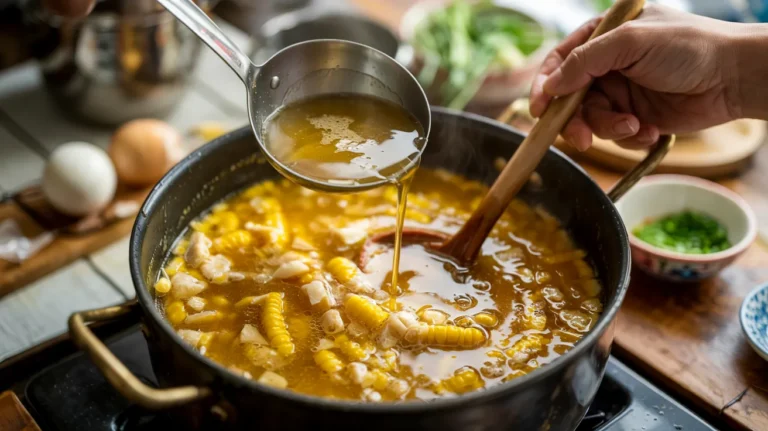Key Takeaways:
- Master the iconic Long John Silvers Fish Batter with this 30-minute copycat recipe
- The secret club soda and double-frying technique create that signature crunch
- Perfect for cod, pollock, or haddock – using the same fish types as the restaurant
- Simple 4-person recipe with pantry ingredients you already have at home
Why You Need This Long John Silvers Fish Batter Recipe
Have you tried making crispy fish at home only to end up with soggy, disappointing results? That perfect Long John Silvers Fish Batter seems impossible to recreate in your own kitchen.
The secret to that signature crackly crust has eluded home cooks for years. Creating the authentic Long John Silvers Fish Batter requires more than just mixing flour and water – it needs the right ingredients and technique.
This Long John Silvers Fish Batter recipe solves your fish fry frustrations with an authentic copycat formula. You’ll create that same crispy coating using basic pantry ingredients, and I’ll walk you through every step of the process.
If you enjoy fish dishes, you might also like my Indian Fish Pie Recipe for another family-friendly seafood option.
Let’s make that restaurant-quality fish experience in your kitchen tonight!
Nutrition Facts
| Nutrient | Amount per Serving |
|---|---|
| Calories | 385 |
| Protein | 24g |
| Carbohydrates | 32g |
| Fat | 16g |
| Fiber | 1g |
| Sugar | 1g |
| Sodium | 580mg |
Note: Nutrition calculated based on using cod fillets with the batter recipe. Values may vary based on specific ingredients used.
What You’ll Need for Long John Silvers Fish Batter
Ingredients
| Ingredient | Amount | Notes |
|---|---|---|
| All-purpose flour | 2 cups | Unbleached works best |
| Cornstarch | 2 tablespoons | Creates extra crispiness |
| Baking powder | 1 tablespoon | For light, airy texture |
| Salt | 1 teaspoon | Table salt, not kosher |
| Garlic powder | 1/2 teaspoon | Adds subtle flavor |
| Onion powder | 1/2 teaspoon | For depth of flavor |
| Paprika | 1/4 teaspoon | For color and mild flavor |
| White pepper | 1/4 teaspoon | More subtle than black pepper |
| Club soda | 1 1/2 cups | Very cold for best results |
| Cod fillets | 1 1/2 pounds | Cut into 4-inch pieces |
| Vegetable oil | 4 cups | For frying |
Kitchen Tools
| Tool | Purpose |
|---|---|
| Deep fryer or large pot | For frying the fish |
| Candy/deep fry thermometer | To monitor oil temperature accurately |
| Large mixing bowl | For preparing batter |
| Medium bowl | For holding fish |
| Whisk | For mixing batter ingredients |
| Tongs | For handling fish safely |
| Spider strainer or slotted spoon | For removing fish from oil |
| Paper towels | For patting fish dry |
| Baking sheet with wire rack | For draining and keeping fish crispy |
| Measuring cups and spoons | For accurate measurements |
| Kitchen timer | To track frying time |
| Instant-read thermometer | To check fish internal temperature |
Possible Substitutions
- Cod substitutes: Haddock, pollock, or tilapia work well
- Club soda alternatives: Cold beer or seltzer water (will change flavor slightly)
- Oil options: Canola, peanut, or sunflower oil are good choices
- Gluten-free option: Replace flour with gluten-free all-purpose flour blend
- Cornstarch substitute: Potato starch or arrowroot powder
Step-by-Step Long John Silvers Fish Batter Instructions
Prep Time: 15 minutes
Cook Time: 15 minutes
Total Time: 30 minutes
Servings: 4 people
Preparation Phase
- Set up your workstation
- Clear a large counter space with room for raw fish, batter, and finished fish
- Designate “raw” and “cooked” areas to prevent cross-contamination
- Place your thermometer on the counter where you can easily see it
- Have a kitchen timer ready or use your phone’s timer function
- Keep a clean kitchen towel nearby for wiping hands
- Prepare the draining station
- Take a baking sheet and line it completely with paper towels
- Place a wire cooling rack on top of the paper towels
- This two-layer setup allows oil to drip away from the fish
- Position this close to your frying area but not so close that oil might splatter on it
- Prepare the fish
- Remove fish fillets from refrigerator 15 minutes before cooking
- Inspect each fillet carefully for any remaining bones
- If you find bones, remove them using clean tweezers or fish pliers
- Hold the fish flat against the cutting board and pull bones straight out
- Rinse fish under cold water (optional)
- Pat each piece VERY dry with paper towels (moisture prevents crispy coating!)
- Continue patting until no moisture remains on the surface
- Cut fish into even 4-inch by 2-inch pieces, about 1-inch thick
- Try to make all pieces similar size for even cooking
- Season both sides lightly with a pinch of salt
- Place fish pieces on a plate lined with paper towels
- Return fish to refrigerator while preparing batter
- Prepare the frying oil
- Choose a heavy-bottomed pot or Dutch oven at least 5 inches deep
- Never fill the pot more than halfway with oil
- Pour vegetable oil into pot, leaving at least 3 inches from top
- Clip candy/deep fry thermometer to side of pot
- Make sure thermometer bulb is in oil but not touching bottom of pot
- Place pot on burner and turn heat to medium-high
- Allow oil to gradually heat to 375°F (190°C)
- This may take 10-15 minutes – be patient!
- Watch thermometer closely – correct temperature is critical
Long John Silvers Fish Batter Assembly
- Mix dry ingredients
- While oil heats, place a large mixing bowl on the counter
- Measure and add 2 cups of all-purpose flour to bowl
- Measure and add 2 tablespoons cornstarch
- Measure and add 1 tablespoon baking powder
- Measure and add 1 teaspoon salt
- Measure and add 1/2 teaspoon garlic powder
- Measure and add 1/2 teaspoon onion powder
- Measure and add 1/4 teaspoon paprika
- Measure and add 1/4 teaspoon white pepper
- Whisk all dry ingredients thoroughly for at least 30 seconds
- This ensures even distribution of spices and leavening
- Look for a uniform color throughout the mixture
- Prepare the batter
- Keep club soda in refrigerator until the last possible moment
- Remove cold club soda from refrigerator
- Measure exactly 1 1/2 cups club soda
- Create a well in center of dry ingredients with your whisk
- Pour about 1/3 of the cold club soda into the well
- Begin whisking from the center, gradually incorporating flour
- Continue adding club soda in small amounts while whisking
- Whisk with a gentle lifting motion – not vigorously!
- IMPORTANT FOR BEGINNERS: Stop mixing as soon as ingredients are combined
- Small lumps are perfectly fine and actually desirable!
- Overmixing will develop gluten and make batter tough
- The finished batter should coat the back of a spoon
- When you lift the spoon, batter should run off in a thick ribbon
- If too thick, add 1 tablespoon more club soda
- If too thin, add 1 tablespoon more flour
Frying Process
- Test the oil and batter
- Double-check oil temperature – must be exactly 375°F (190°C)
- If too hot, remove from heat briefly
- If too cool, increase heat slightly
- Drop a small amount of batter (1/2 teaspoon) into oil
- Watch the batter carefully:
- Should bubble vigorously immediately
- Should rise to surface within 2-3 seconds
- Should begin turning golden within 15 seconds
- If batter sinks and doesn’t bubble, oil isn’t hot enough
- If batter browns instantly, oil is too hot
- Adjust temperature as needed and test again
- Prepare for frying
- Place batter bowl close to the pot of oil
- Have your tongs and spider strainer/slotted spoon ready
- Remove fish from refrigerator
- Set up a “landing zone” with your prepared wire rack
- Have a plate lined with paper towels as backup
- Set timer or phone nearby for timing
- If you have glasses or goggles, wear them to protect from splatter
- Roll up sleeves and remove jewelry from hands and wrists
- Coat the fish
- Take one piece of fish and verify it’s completely dry
- Hold fish by one end
- Dip fish into batter, fully submerging it
- Ensure all surfaces are coated
- Lift and let excess batter drip back into bowl for 2-3 seconds
- Hold fish above bowl until dripping slows
- The coating should be even, not too thick or thin
- First fry (gentle cooking)
- Check oil temperature one last time – still 375°F (190°C)?
- Turn heat down slightly to maintain temperature during frying
- Hold battered fish just above the oil surface
- Gently lower one end into oil, then the rest of the piece
- BEGINNER SAFETY TIP: Lower away from you to prevent splatter burns
- Let go with tongs once fish is in oil
- Step back slightly to avoid any oil splatter
- Add only 2-3 pieces at a time – overcrowding lowers oil temperature
- Don’t touch the fish for 30 seconds – let batter set!
- Fry for 2 minutes total
- Fish should be light golden, not dark brown yet
- Gently turn once halfway through with tongs or spider
- Watch for hot spots in your oil – move fish if one area browns faster
- Remove fish when light golden and place on wire rack
- Let rest for 3 minutes – this is the secret to extra crispiness!
- Second fry (crisping)
- Return oil to 375°F (190°C) exactly
- Carefully place par-fried fish back into hot oil
- Fry for additional 1-2 minutes until deep golden brown
- This double-fry technique creates the signature Long John Silvers crunch
- Watch carefully – fish can go from perfect to burnt quickly
- Check that internal temperature reaches 145°F (63°C) with instant-read thermometer
- Remove fish with spider strainer or slotted spoon
- Let excess oil drip back into pot for 5 seconds
- Place on wire rack to drain
- Rest for 1 minute before serving
- Finishing and serving
- Place fried fish on serving platter
- If making multiple batches, keep finished pieces warm in 200°F (93°C) oven
- Sprinkle with a tiny bit of salt while still hot if desired
- Fish should have a distinctive crackly sound when tapped with tongs
- Serve immediately for maximum crispiness
- For an authentic fish feast, consider serving it with my Braised Yellow Croaker Fish with Garlic for a complete seafood spread
- Traditional accompaniments include:
- Malt vinegar (in small dish for dipping)
- Tartar sauce
- Coleslaw
- Lemon wedges
- Hush puppies
After Cooking
- Clean up safely
- Turn off heat under oil
- Let oil cool completely in pot (several hours)
- Never pour hot oil down drain!
- Once cool, strain through fine mesh strainer
- Store filtered oil in original bottle for reuse (not more than 2-3 times)
- Wash all tools in hot, soapy water
- Wipe down all surfaces to remove any oil splatter

Troubleshooting Your Long John Silvers Fish Batter
| Problem | Possible Cause | Solution |
|---|---|---|
| Batter not sticking to fish | Fish too wet | Pat fish completely dry before coating |
| Fish too cold | Let fish sit at room temperature for 5-10 minutes | |
| Batter too thick | Too much flour or too little liquid | Add more club soda, 1 tablespoon at a time |
| Batter too thin | Too much liquid | Add more flour, 1 tablespoon at a time |
| Fish not crispy | Oil temperature too low | Maintain oil at 375°F (190°C) |
| Skipped second fry | Always use the double-fry method | |
| Greasy fish | Oil temperature too low | Use thermometer to maintain correct temperature |
| Improper draining | Use wire rack instead of paper towels alone | |
| Batter browning too quickly | Oil temperature too high | Reduce heat slightly |
| Too much sugar in batter | Ensure no sugar was accidentally added | |
| Batter falling off when frying | Fish moved too soon in oil | Let fish cook undisturbed for first minute |
| Batter too thin | Add a bit more flour to thicken | |
| Batter too pale | Oil not hot enough | Increase temperature to 375°F |
| Removed too soon | Fry until golden brown | |
| Harsh flavor | Old oil used | Always use fresh oil for best flavor |
Variations & Substitutions for Long John Silvers Fish Batter
Flavor Variations
- Spicy version: Add 1/2 teaspoon cayenne pepper to dry ingredients
- Herb-infused: Add 1 tablespoon dried dill or parsley to batter
- Beer batter: Replace club soda with cold beer for deeper flavor
- Cajun style: Add 1 teaspoon Cajun seasoning to dry ingredients
- Lemon pepper: Add 1 teaspoon lemon zest and 1/2 teaspoon extra pepper
- Extra crunchy: Add 1/4 cup cornmeal to the dry ingredients
- Southern style: Add 1/4 teaspoon Old Bay seasoning
Dietary Modifications
- Gluten-free: Use gluten-free flour blend and ensure baking powder is gluten-free
- Lower sodium: Reduce salt to 1/2 teaspoon
- Dairy-free: This recipe is naturally dairy-free
- Egg-free: This recipe contains no eggs
- Lower carb: Use 1/4 cup almond flour mixed with regular flour (will change texture)
Storage & Reheating Tips
Storage Guidelines
- Refrigeration: Store leftover fried fish in airtight container for up to 2 days
- Separate layers: Place parchment paper between layers of fish to prevent sticking
- Freezing cooked fish: Place cooled fish on baking sheet, freeze until solid, then transfer to freezer bag for up to 1 month
- Storing unused batter: Not recommended – batter is best used immediately
- Freezing uncooked fish: If you prepped too much fish, freeze uncoated pieces for later use
Reheating Methods
- Oven method (best for maintaining crispiness)
- Preheat oven to 350°F (175°C)
- Place fish on wire rack over baking sheet
- Reheat for 10-15 minutes until heated through and crispy
- Check at 10 minutes to prevent over-drying
- Air fryer method
- Preheat air fryer to 350°F (175°C)
- Place fish in single layer in basket
- Heat for 3-4 minutes until crispy and hot
- Don’t overcrowd – work in batches if needed
- Toaster oven method
- Preheat toaster oven to 350°F (175°C)
- Place fish on toaster oven tray
- Heat for 8-10 minutes until crispy and heated through
- Avoid microwave reheating
- Microwave will make the crispy coating soggy
- If necessary, use defrost setting and finish in toaster oven
Safety Notes & Expert Tips
Food Safety
- Fish must reach internal temperature of 145°F (63°C)
- Use separate cutting boards for fish and other foods
- Never reuse oil that has been used for raw fish
- Keep raw fish refrigerated until ready to use
- Wash hands thoroughly with soap after handling raw fish
- Don’t leave cooked fish at room temperature for more than 2 hours
Frying Safety
- Keep a kitchen fire extinguisher nearby
- Never leave hot oil unattended – not even for a minute!
- Use a deep pot with plenty of room for oil expansion
- Keep water away from hot oil – they don’t mix!
- Have pot lid nearby to smother flames if needed
- Keep children and pets away from frying area
- Turn pot handles inward to prevent accidental knocking
- Allow oil to cool completely before disposing
- Have burn cream in your first aid kit just in case
Pro Tips for Long John Silvers Fish Batter Success
- For extra crispiness: Let battered fish rest on a wire rack for 2-3 minutes before first fry
- Temperature control: Return oil to 375°F between batches – use your thermometer!
- Consistent pieces: Cut fish into similar sizes for even cooking – use a ruler if needed
- Make ahead option: Prepare dry mix in advance and add liquid just before cooking
- Oil filtering: Strain cooled oil through fine mesh strainer lined with cheesecloth for reuse
- Testing doneness: Fish should flake easily with fork when fully cooked
- Preventing splatter: Add a pinch of salt to oil before frying (old chef’s trick)
- Hands-free option: Use chopsticks to dip and handle fish for less messy fingers
- Perfect pairing: For a complete meal, try my Corn and Fish Maw Soup as a starter before serving your main dish of crispy fish
- Extra authentic touch: Sprinkle with malt vinegar just before serving
Now you can enjoy that classic Long John Silvers fish experience without leaving home! This batter recipe creates that perfect crispy coating that makes the restaurant version so popular. With these detailed instructions, even complete beginners can achieve restaurant-quality results every time. The double-fry technique is the real secret to that signature crunch that keeps people coming back for more!




